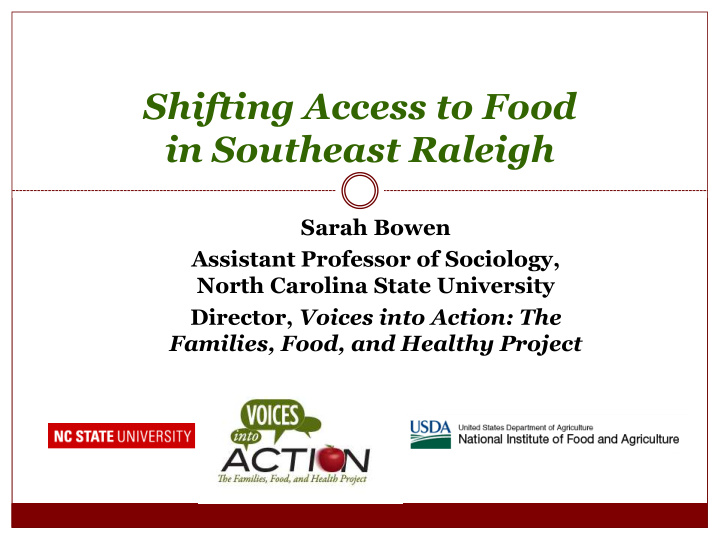



Shifting Access to Food in Southeast Raleigh Sarah Bowen Assistant Professor of Sociology, North Carolina State University Director, Voices into Action: The Families, Food, and Healthy Project
Voices into Action Voices: Interviews with mothers about their experiences feeding their families (n=120) Food assessments to identify community strengths and priorities related to food access Action: Working with faith communities and community organizations to facilitate projects to improve access to healthy and affordable food and safe places to be active
Southeast Raleigh
Availability of fresh produce Convenience Convenience Supermarkets Stores Supermarkets Stores (n = 4) (n = 24) (n = 4) (n = 24) Carrots Bananas 100% 8% 100% 8% Tomatoes Apples 100% 12% 100% 8% Lettuce Oranges 100% 8% 75% 4% Sweet peppers Grapes 100% 4% 100% 8% Broccoli Cantaloupe 100% 0% 100% 4% Cauliflower Strawberries 100% 0% 100% 4% Cabbage Pears 100% 0% 100% 4% Green beans 75% 0%
Availability of canned vegetables Convenience Supermarkets Stores (n = 4) (n = 24) Canned corn 100% 68% Canned green beans 100% 52%
Availability of healthier options (milk and bread) Convenience Supermarkets Stores (n = 4) (n = 24) Whole wheat bread 100% 24% White bread 100% 88% Convenience Supermarkets Stores (n = 4) (n = 24) Reduced fat milk 100% 48% Whole milk 100% 68%
Comparing prices Convenience Supermarkets Stores White bread (loaf) $3.42 $3.41 Wheat bread (loaf) $3.82 $4.19 Milk (0.5 gal) $2.76 $3.40 Apples (lb) $0.56 $1.94 Canned corn (1 can) $1.16 $1.74 • On average, convenience stores charged 66% more for these 5 items.
Interviews with residents of Southeast Raleigh 40 interviews Average household income: $15,000/year Most lived more than 1 mile from a supermarket 48% did not have a car 53% considered food insecure
Where do people shop? Families prioritized affordability over proximity. Many preferred to bypass nearby corner and convenience stores to reach large supermarkets. Complicating factors: Lack of transportation Challenges making budgets or SNAP benefits last Result: Many families shopped just once a month, buying mostly non-perishables.
Where do people shop? “ We would rather do it that way and get it for cheap than risk …[running] down to the corner store for anything. And they triple the price of stuff than say at a supermarket.” - Ramira
Where do people shop? “[Ideally] I would get a lot of— I would get salads and vegetables and I would just — because those are perishable things and they go bad really fast… We don’t have the money to keep traveling back and forth every day to the market.” - Ramira
Healthier corner stores Provide support: infrastructure, information, marketing Foster connections between corner stores and local farmers Adapt to local contexts Build viable, healthy markets for local food
Recommend
More recommend